The 2003 Subaru Outback, a name synonymous with rugged reliability and versatility, holds a special place in automotive history. This generation of the Outback marked a significant shift in the SUV landscape, introducing a blend of car-like handling and off-road capability that resonated with drivers seeking adventure and practicality.
Its distinctive design, powerful engine options, and commitment to safety made it a popular choice for families and outdoor enthusiasts alike.
This comprehensive review delves into the key features, performance, and legacy of the 2003 Subaru Outback, providing valuable insights for prospective buyers and enthusiasts alike. We’ll explore its design, engine options, fuel efficiency, reliability, safety features, and overall value proposition, offering a detailed look at what makes this vehicle so enduring.
Overview
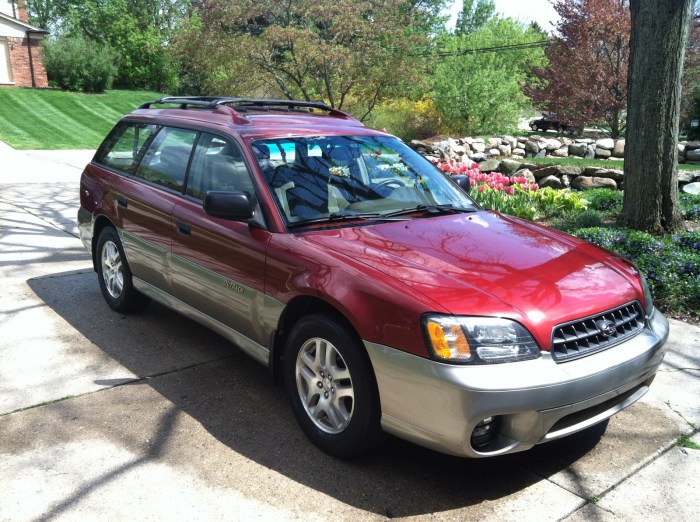
The 2003 Subaru Outback is a compact wagon that marked a significant step forward for the Japanese automaker. It was the third generation of the Outback model, building upon the success of its predecessors and establishing itself as a popular choice for those seeking a versatile and capable vehicle.
This generation of the Outback was notable for its refined design, improved handling, and increased interior space. It offered a blend of car-like comfort and SUV-like capability, making it a compelling option for a wide range of drivers.
Key Features and Specifications
The 2003 Subaru Outback was available with two engine options: a 2.5-liter four-cylinder engine producing 165 horsepower and a 3.0-liter six-cylinder engine producing 212 horsepower. Both engines were paired with a four-speed automatic transmission, with the option of a five-speed manual transmission for the four-cylinder engine.
The Outback’s standard features included power windows, power locks, air conditioning, and a CD player. Higher trim levels offered additional amenities such as leather upholstery, heated seats, and a sunroof.
- All-Wheel Drive (AWD):The Outback’s hallmark feature was its standard symmetrical all-wheel drive system, which provided excellent traction and stability in a variety of weather conditions. This system distributed power evenly to all four wheels, enhancing its off-road capabilities and making it a reliable choice for drivers in snowy or rainy climates.
- Spacious Interior:The 2003 Outback offered ample passenger and cargo space. Its versatile seating arrangement allowed for multiple configurations, making it suitable for both everyday commutes and weekend adventures.
- Safety Features:The Outback came equipped with standard safety features such as anti-lock brakes (ABS), driver and passenger airbags, and side curtain airbags. These features contributed to its reputation as a safe and reliable vehicle.
Significance in the Automotive Industry
The 2003 Subaru Outback played a pivotal role in shaping the automotive landscape. Its combination of practicality, capability, and style resonated with a wide audience, contributing to Subaru’s growing popularity in the United States and beyond. The Outback’s success helped establish Subaru as a leader in the all-wheel drive segment, and its legacy continues to influence the design and features of modern SUVs and crossovers.
Design and Styling
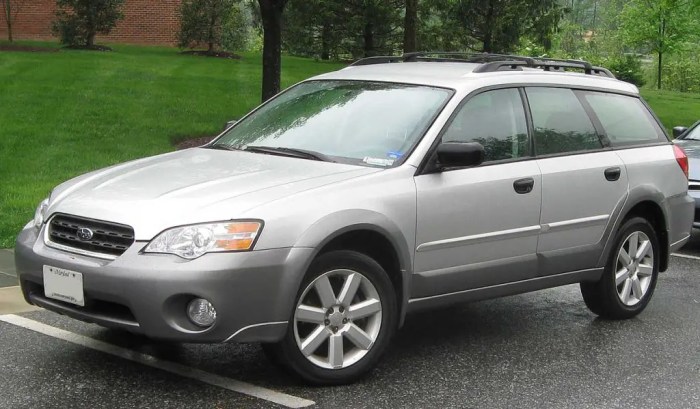
The 2003 Subaru Outback, a popular choice for its practicality and versatility, features a distinctive design that blends ruggedness with a touch of sophistication. The Outback’s design reflects Subaru’s commitment to building vehicles that are both functional and stylish.
Exterior Design
The 2003 Subaru Outback boasts a robust exterior design that emphasizes its off-road capabilities. The high ground clearance, rugged body cladding, and prominent wheel arches contribute to its rugged aesthetic. The Outback’s design is characterized by its boxy shape, which maximizes interior space and cargo capacity.
The front fascia features a large grille with a prominent Subaru badge, flanked by angular headlights. The side profile showcases the Outback’s elevated stance and the sloping roofline that contributes to its aerodynamic efficiency. The rear end is characterized by a wide tailgate and vertical taillights, adding to the Outback’s distinctive profile.
Interior Design and Comfort Features
The 2003 Subaru Outback’s interior is designed with practicality and comfort in mind. The cabin features a spacious layout with comfortable seating for five passengers. The dashboard is functional and user-friendly, with clear instrumentation and easy-to-use controls. The Outback offers a range of comfort features, including air conditioning, power windows, and a premium sound system.
The high seating position provides excellent visibility, enhancing driver confidence. The interior materials are durable and well-constructed, reflecting Subaru’s focus on practicality.
Overall Aesthetics and Appeal
The 2003 Subaru Outback’s design successfully combines practicality and style. Its rugged exterior design appeals to those seeking an adventurous vehicle, while its comfortable and functional interior caters to both drivers and passengers. The Outback’s overall aesthetic reflects Subaru’s commitment to building vehicles that are both capable and appealing.
The Outback’s unique design, combined with its reputation for reliability and performance, has made it a popular choice among drivers seeking a versatile and stylish vehicle.
Performance and Handling
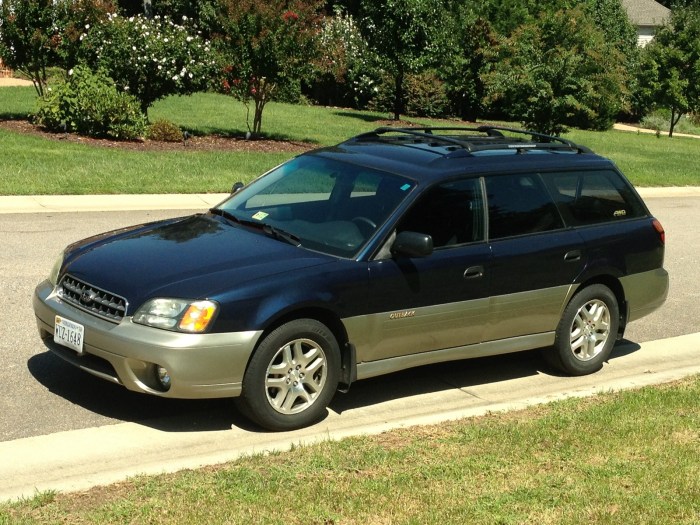
The 2003 Subaru Outback offered a blend of practicality and capability, thanks to its robust engine options and well-tuned suspension. This made it a popular choice for drivers who valued both on-road comfort and off-road versatility.
Engine Options
The 2003 Subaru Outback was available with two engine choices, both known for their reliability and fuel efficiency:
- 2.5-liter 4-cylinder engine:This engine produced 165 horsepower and 166 lb-ft of torque. It was the standard engine for the Outback and provided adequate power for everyday driving. It was paired with a 5-speed manual or a 4-speed automatic transmission.
- 3.0-liter 6-cylinder engine:This engine generated 212 horsepower and 210 lb-ft of torque. It was available on the higher trim levels and offered a more spirited driving experience. It came with a 5-speed automatic transmission.
Performance Characteristics
The 2003 Subaru Outback’s performance was generally praised for its balance between power and fuel economy.
- Acceleration:The 2.5-liter engine provided sufficient acceleration for daily commutes and highway merging. The 3.0-liter engine offered a more responsive and powerful experience, making it suitable for towing and carrying heavy loads.
- Braking:The Outback featured disc brakes on all four wheels, providing reliable stopping power. The braking system was known for its responsiveness and consistent performance, offering confidence in various driving conditions.
- Handling:The Subaru Outback was known for its balanced handling, thanks to its independent suspension system and all-wheel drive. It provided a comfortable ride on paved roads while offering impressive stability and control on rough terrain. The car’s low center of gravity contributed to its agile handling and stability, especially during cornering.
Comparison to Competitors
The 2003 Subaru Outback was positioned in the compact crossover SUV segment, competing with vehicles like the Toyota RAV4, Honda CR-V, and Ford Escape. Compared to its competitors, the Outback stood out for its all-wheel drive system, which offered superior traction and handling in adverse weather conditions.
Its spacious interior and cargo capacity were also competitive advantages. While some competitors might have offered slightly more powerful engine options, the Outback’s overall balance of performance, fuel efficiency, and practicality made it a compelling choice in its class.
Fuel Efficiency and Environmental Impact
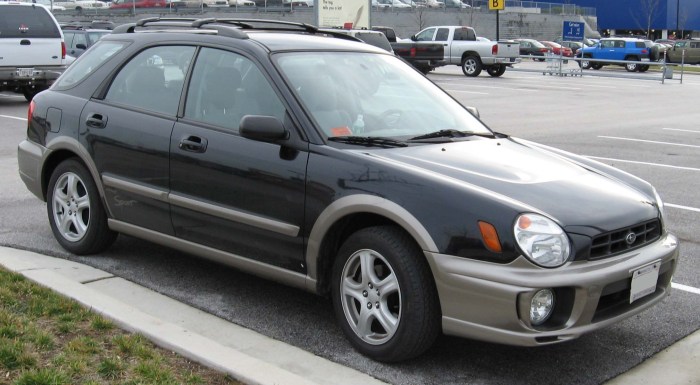
The 2003 Subaru Outback offered a balance of practicality and fuel efficiency, making it a popular choice for those seeking a capable vehicle without sacrificing economy.
Fuel Economy Ratings
The 2003 Subaru Outback came equipped with two engine options, each impacting its fuel efficiency.
- The 2.5-liter four-cylinder engine achieved an estimated fuel economy of 21 mpg city, 27 mpg highway, and 23 mpg combined.
- The 3.0-liter six-cylinder engine delivered an estimated fuel economy of 19 mpg city, 25 mpg highway, and 21 mpg combined.
Environmental Impact
The 2003 Subaru Outback’s environmental impact was influenced by its fuel consumption and emissions. The four-cylinder engine, with its lower fuel consumption, emitted less greenhouse gases compared to the six-cylinder engine.
The Environmental Protection Agency (EPA) estimates that the average passenger vehicle emits 4.6 metric tons of carbon dioxide per year.
The Outback’s emissions were in line with other vehicles in its class, although advancements in fuel efficiency and emission control technologies have led to significant reductions in newer models.
Comparison to Other Vehicles
The 2003 Subaru Outback’s fuel efficiency was competitive with other compact SUVs and station wagons of its time.
- The Toyota RAV4, a direct competitor, offered similar fuel economy with its four-cylinder engine, achieving 21 mpg city, 27 mpg highway, and 23 mpg combined.
- The Honda CR-V, another popular option, achieved 21 mpg city, 27 mpg highway, and 23 mpg combined with its four-cylinder engine.
Reliability and Durability
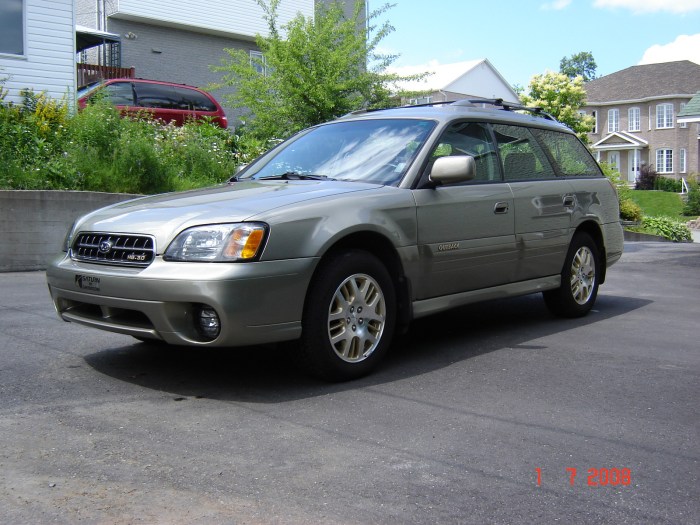
The 2003 Subaru Outback is known for its robust construction and reputation for reliability. Owners often praise its ability to withstand the test of time and endure various driving conditions. However, like any vehicle, it has its share of potential issues and maintenance requirements.
The 2003 Subaru Outback, known for its rugged all-wheel drive capabilities and versatile wagon design, was a popular choice for adventurous drivers. While the Outback was focused on practicality, Subaru also offered the 2005 Subaru Baja , a unique pickup truck that blended the Outback’s ruggedness with a more utilitarian bed.
The Baja, however, was discontinued in 2006, leaving the Outback as the sole Subaru wagon offering, continuing to cater to those seeking a balance of comfort and off-road capability.
Common Issues and Maintenance Requirements
The 2003 Subaru Outback, like any vehicle, is prone to certain common issues. These issues, while not universal, are often reported by owners. Understanding these potential problems can help owners prepare for potential maintenance needs and ensure their Outback remains in optimal condition.
- Engine Issues: The 2.5-liter four-cylinder engine is known for its reliability, but some owners have reported issues with the head gasket, particularly in higher mileage vehicles. This issue can lead to coolant leaks and overheating. Regular maintenance, including timely coolant flushes, can help prevent this problem.
- Transmission Problems: The automatic transmission, while generally reliable, can experience issues with shifting and slipping, particularly in older models. Regular fluid changes and proper maintenance are crucial for optimal transmission performance.
- Suspension Wear: The Subaru Outback’s suspension system is designed for off-road capability, but it can experience wear and tear over time. Common issues include worn-out struts, shocks, and ball joints. These components should be inspected regularly and replaced as needed.
- Electrical Problems: Older Outbacks can experience electrical issues, such as faulty sensors, wiring problems, and issues with the alternator. These issues can lead to a variety of symptoms, including engine problems, lighting issues, and malfunctioning gauges.
- Rust and Corrosion: Due to its use of steel in the body, the 2003 Subaru Outback can be susceptible to rust and corrosion, especially in areas with harsh climates. Regular inspections and preventative measures, such as undercoating, can help mitigate this issue.
Safety Features
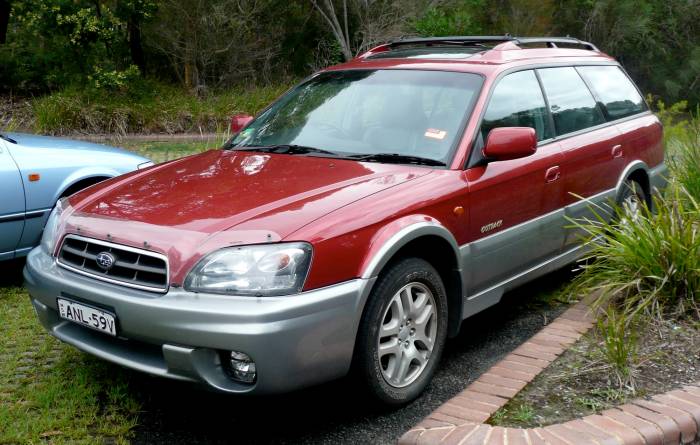
The 2003 Subaru Outback was designed with a comprehensive suite of safety features to protect occupants in the event of an accident. These features include both passive and active safety systems, aiming to prevent accidents and minimize injuries in case of a collision.
Safety Features and Their Function
The 2003 Subaru Outback came standard with several safety features designed to protect occupants in a crash.
- Dual Front Airbags:These airbags deploy in a frontal collision to cushion the driver and front passenger, reducing the risk of head and chest injuries.
- Side Airbags:Some models were equipped with optional side airbags, providing additional protection for the driver and front passenger in a side impact collision.
- Anti-lock Braking System (ABS):This system prevents the wheels from locking up during braking, allowing the driver to maintain steering control and avoid skidding.
- Electronic Brakeforce Distribution (EBD):This system automatically adjusts brake pressure to each wheel, ensuring optimal braking performance in different situations.
- Child Safety Locks:These locks prevent children from opening the rear doors from the inside, enhancing safety for young passengers.
- Three-Point Seatbelts:All seating positions were equipped with three-point seatbelts, designed to secure occupants in a crash and distribute forces across the body.
- Head Restraints:The Outback’s head restraints were designed to reduce the risk of whiplash injury in a rear-end collision.
Safety Ratings and Crash Test Performance
The 2003 Subaru Outback received positive safety ratings from the National Highway Traffic Safety Administration (NHTSA) and the Insurance Institute for Highway Safety (IIHS).
- NHTSA:The Outback earned a four-star rating in frontal impact testing and a five-star rating in side impact testing.
- IIHS:The Outback received a “Good” rating in the frontal offset crash test, a “Good” rating in the side impact crash test, and a “Good” rating in the rear impact crash test.
Comparison of Safety Features to Other Vehicles in Its Class
The 2003 Subaru Outback’s safety features were comparable to other vehicles in its class. While the standard safety features were relatively common, some competitors offered optional advanced safety features like electronic stability control (ESC) and traction control. However, the Outback’s strong crash test performance and standard safety features positioned it well in the segment.
Interior Space and Comfort
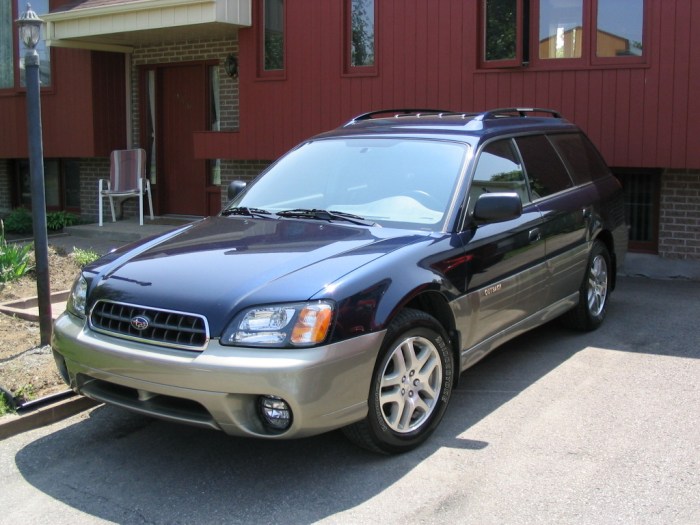
The 2003 Subaru Outback offers a spacious and comfortable interior, designed to accommodate both passengers and cargo with ease. The cabin provides ample legroom and headroom for both front and rear passengers, making it a practical choice for families or individuals who frequently carry passengers.
The 2003 Subaru Outback, known for its rugged all-wheel drive system and spacious interior, represented a significant step forward in Subaru’s commitment to practical and capable vehicles. While the Outback was a mainstream success, Subaru’s heritage in smaller, more utilitarian vehicles like the 1992 Subaru Sambar played a key role in shaping the brand’s reputation for reliability and durability.
This legacy continues to influence Subaru’s design and engineering philosophy, ensuring that even modern models like the 2003 Outback embody the brand’s core values.
Seating Comfort
The Outback’s seating is designed for comfort and support. The front seats are supportive and adjustable, allowing drivers and passengers to find a comfortable driving position. The rear seats offer ample legroom and headroom, even for taller passengers. The seats are upholstered in durable fabric, providing a comfortable ride for all occupants.
Cargo Space
The 2003 Subaru Outback boasts a generous cargo space. The rear seats fold down to provide a large and flat loading area, making it suitable for hauling large items. The cargo area is well-lit and features tie-down hooks for securing cargo.
The Outback’s cargo space is ideal for transporting luggage, groceries, camping gear, or other items.
Climate Control, 2003 Subaru Outback
The Outback’s climate control system ensures a comfortable interior temperature throughout the year. The standard air conditioning system effectively cools the cabin during hot weather, while the optional heated seats provide warmth in colder temperatures. The Outback’s climate control system is easy to operate and effectively maintains a comfortable temperature, making it a pleasant vehicle to ride in various weather conditions.
Overall Comfort and Practicality
The 2003 Subaru Outback is a comfortable and practical vehicle that offers a balance of passenger space, cargo capacity, and comfort features. The spacious interior, comfortable seating, and generous cargo space make it a versatile vehicle for various uses. Whether it’s for daily commuting, weekend trips, or hauling cargo, the Outback’s interior provides a comfortable and practical experience.
Technology and Features: 2003 Subaru Outback
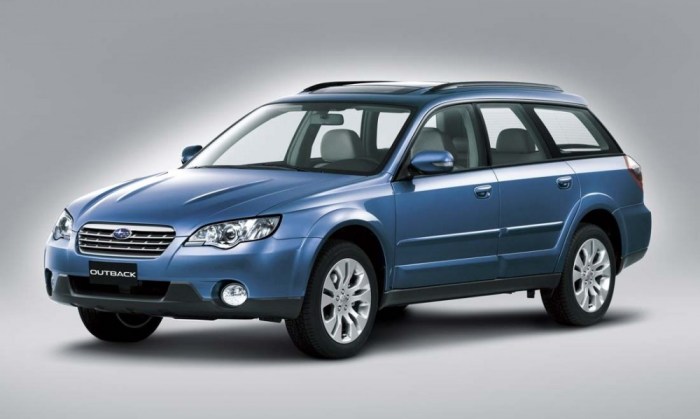
The 2003 Subaru Outback offered a range of technology features for its time, aimed at enhancing driver convenience, safety, and entertainment. While not as advanced as modern vehicles, its technology features were considered competitive for its class.
Infotainment System
The 2003 Subaru Outback featured an AM/FM stereo system as standard, with optional features like a CD player and a cassette player. The audio system was typically equipped with four speakers, providing basic audio entertainment.
The 2003 Subaru Outback, known for its ruggedness and all-wheel drive capability, represented a significant evolution from its earlier iterations. While the Outback was already a popular choice for those seeking a blend of practicality and off-road prowess, its roots can be traced back to the 1986 Subaru Leone , a model that first introduced the world to Subaru’s innovative symmetrical all-wheel drive system.
This pioneering technology, which would become a defining characteristic of the Subaru brand, laid the foundation for the Outback’s enduring legacy of off-road capability and driver confidence.
Navigation
Navigation systems were not standard in the 2003 Subaru Outback. For navigation, drivers relied on traditional map-based methods or aftermarket navigation devices.
Other Technology Features
The 2003 Subaru Outback included other technology features, such as:
- Power windows and locks:These were standard features, offering convenience for drivers and passengers.
- Cruise control:This feature allowed drivers to maintain a consistent speed on the highway, reducing fatigue during long drives.
- Air conditioning:Standard air conditioning provided climate control for passenger comfort.
- Rear window defroster:This feature enhanced visibility in cold weather conditions.
Comparison with Other Vehicles in its Class
Compared to other vehicles in its class at the time, the 2003 Subaru Outback offered a decent range of technology features. While some competitors might have offered more advanced infotainment systems or navigation options, the Outback provided a solid foundation of essential technology features for its target audience.
Pricing and Value
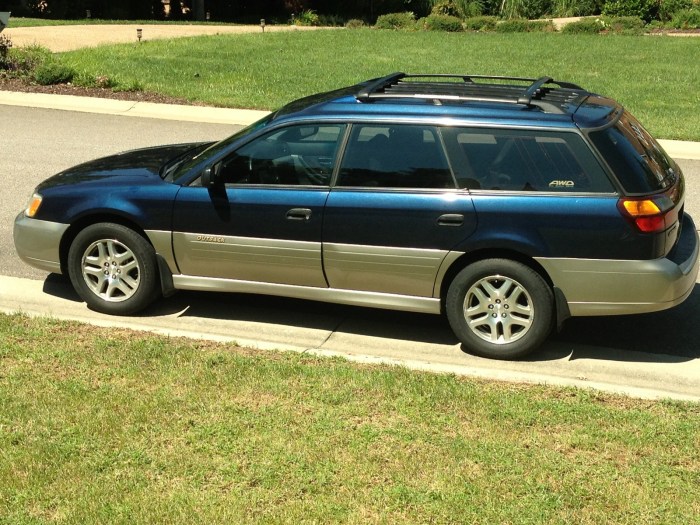
The 2003 Subaru Outback offered a compelling value proposition, balancing affordability with practicality and capability. Its pricing reflected its position as a mid-range SUV, appealing to buyers seeking a blend of car-like handling and off-road versatility.
Original Price
The 2003 Subaru Outback’s original price ranged from around $20,000 for the base model to over $25,000 for higher trim levels and options. This placed it competitively against other compact SUVs of the era, such as the Honda CR-V, Toyota RAV4, and Ford Escape.
Current Market Value
The current market value of a 2003 Subaru Outback varies significantly based on its condition, mileage, and trim level. Generally, well-maintained examples with lower mileage command higher prices. However, the Outback’s reputation for reliability and durability contributes to its relatively strong resale value compared to other vehicles of its age.
Online resources like Kelley Blue Book or Edmunds can provide estimates of current market values based on specific vehicle details.
Resale Potential
The 2003 Subaru Outback’s resale potential is influenced by its age, condition, and overall demand. As a 20-year-old vehicle, its resale value is likely to be lower than newer models. However, its reputation for reliability and off-road capability continues to attract buyers seeking a used SUV with proven performance.
Value Proposition
The 2003 Subaru Outback offered a compelling value proposition for its time, combining:
- Practicality:Spacious interior, ample cargo space, and versatile seating arrangements for passengers and cargo.
- Capability:Symmetrical All-Wheel Drive (AWD) system provided excellent traction and handling in various weather conditions, including snow and light off-road terrain.
- Reliability:Subaru’s reputation for building durable and reliable vehicles contributed to the Outback’s long-term value and low maintenance costs.
- Fuel Efficiency:The Outback’s fuel economy was comparable to other compact SUVs of its era, offering a balance between performance and efficiency.
Compared to other vehicles in its class, the 2003 Subaru Outback stood out for its all-wheel-drive capability, spacious interior, and reputation for reliability, making it a strong contender for buyers seeking a practical and capable SUV.
Legacy and Impact
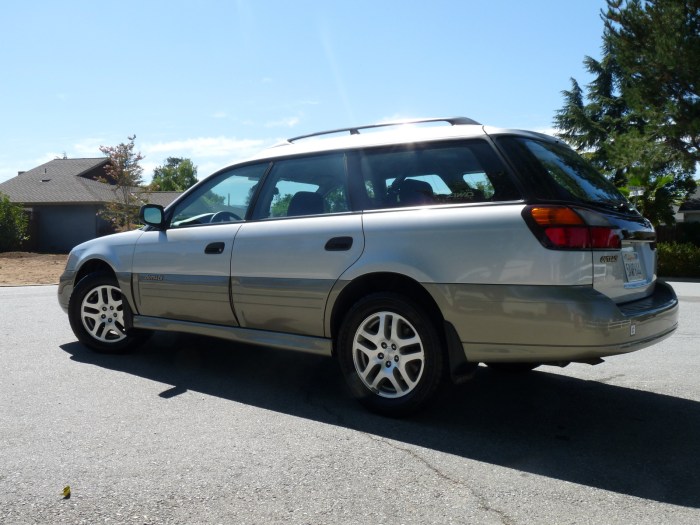
The 2003 Subaru Outback, a pivotal model in the brand’s history, left a lasting mark on the automotive industry, influencing the development of the Subaru brand and shaping the SUV segment. Its success solidified Subaru’s reputation for reliability, versatility, and all-wheel-drive capability, paving the way for future generations of Outback models and contributing significantly to the brand’s growth.
Impact on the Automotive Industry
The 2003 Outback’s success can be attributed to its unique blend of car-like handling, spacious interior, and rugged off-road capabilities. It appealed to a wide range of buyers, including families, outdoor enthusiasts, and those seeking a practical and reliable vehicle.
This versatility contributed to the growing popularity of the SUV segment, making it a dominant force in the automotive market. The Outback’s success demonstrated that consumers were looking for vehicles that offered both practicality and performance, setting a trend that continues to influence automotive design and development.
Role in the Development of the Subaru Brand
The 2003 Outback played a crucial role in establishing Subaru as a leading manufacturer of all-wheel-drive vehicles. Its popularity helped to solidify Subaru’s reputation for reliability and safety, further enhancing the brand’s image. The Outback’s success also paved the way for the development of other successful Subaru models, such as the Forester and the Legacy.
These models, inspired by the Outback’s design and engineering principles, further expanded Subaru’s reach and appeal to a broader customer base.
Legacy and Lasting Influence on the SUV Segment
The 2003 Subaru Outback’s legacy continues to influence the SUV segment. Its focus on practicality, versatility, and all-wheel-drive capability has become a defining characteristic of modern SUVs. The Outback’s success also led to the development of other “crossover” vehicles, which blend the car-like handling of a sedan with the spaciousness and practicality of an SUV.
The Outback’s enduring popularity is a testament to its lasting influence on the SUV segment and its ability to anticipate and meet evolving consumer needs.
Outcome Summary
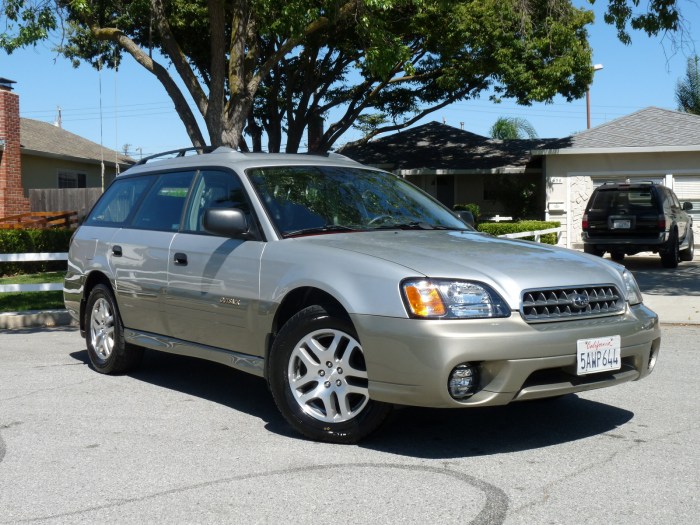
The 2003 Subaru Outback stands as a testament to the brand’s dedication to building vehicles that are both capable and comfortable. Its blend of practicality, performance, and safety continues to make it a desirable choice for those seeking a reliable and versatile companion for their adventures.
Whether you’re navigating city streets or exploring uncharted trails, the 2003 Outback offers a compelling combination of features that make it a true icon in the SUV segment.